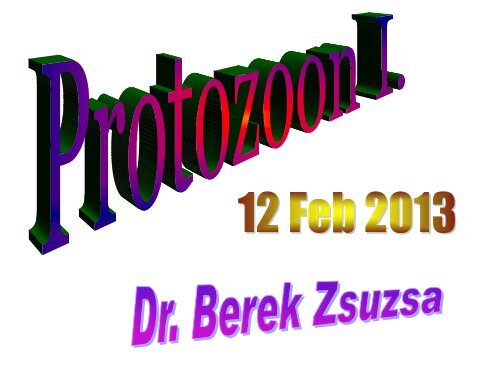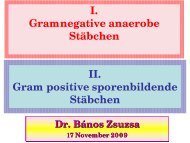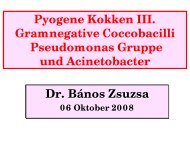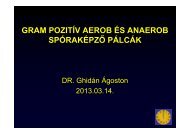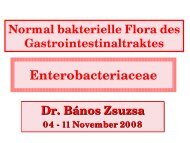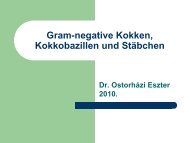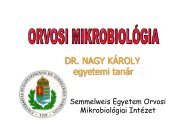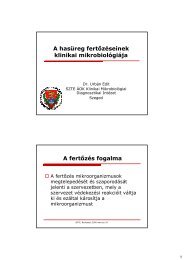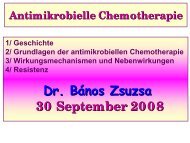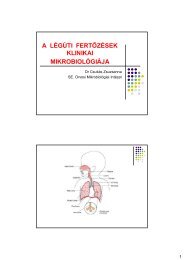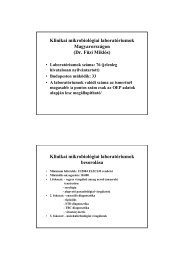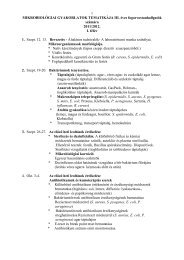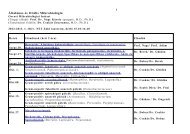Entamoeba histolytica
Entamoeba histolytica
Entamoeba histolytica
You also want an ePaper? Increase the reach of your titles
YUMPU automatically turns print PDFs into web optimized ePapers that Google loves.
Parasitology<br />
Protozoa and Helminths<br />
Classification:<br />
Blood and tissue parasiting Protozoa<br />
Blood and tissue parasiting Helminths<br />
GI tract parasiting Protozoa<br />
GI tract parasiting Helminths
General characterisation<br />
Unicellular, eukaryotic (heterotrophic, anaerobic, aerobic)<br />
Size: 2–80 μm, average 50 μm, „small” 10; „big” 100 μm<br />
Complex life cycle with several stages<br />
Asexual: binary fission;<br />
Apicomplexa both sexual and asexual reproduction<br />
Diverse, complex cell structure<br />
Infections:<br />
Asymptomatic life threatening
General characterisation<br />
Kingdom: Protista (215 000 known species)<br />
Subkingdom: Protozoa (animal-like)<br />
Phylum: 6<br />
100 human adapted<br />
20 human pathogens<br />
Ca. 10 identified whole genom!<br />
Form:<br />
Trophozoite (vegetative – active, feeding, multiplying)<br />
Cyst (survivor – protective membrane/thickened wall)
General characterisation<br />
Terms of trophozoite stages:<br />
Haemoflagellates<br />
Amastigote<br />
Promastigote<br />
Epimastigote<br />
Trypomastigote<br />
??? Flagellum +/-<br />
??? Kinetoplast situated<br />
Apicomplexa<br />
Tachyzoite; Bradyzoite (Toxoplasma gondii)<br />
Merozoite (Plasmodia)<br />
Gametocytes/gametes – sexual stages
General characterisation<br />
Terms in asexual reproduction:<br />
Apicomplexa<br />
Endodyogeny (Toxoplasma)<br />
Schizogony (Plasmodia)<br />
Terms in sexual reproduction:<br />
Apicomplexa<br />
Gametes (gamogony)<br />
Fertilisation Zygote Encystation Oocyst<br />
Inside oocyst: infective sporozoites (sporogony)
Medmicro ch77
Simplified morphological taxonomy<br />
(class, genus, species)<br />
• Lobosea (amoebae)<br />
<strong>Entamoeba</strong><br />
Naegleria, Acanthamoeba<br />
• Flagellata<br />
Giardia, Trichomonas<br />
Leishmania , Trypanosoma<br />
• Sporozoa (apicomplexa)<br />
Cryptosporidium<br />
Toxoplasma,<br />
Plasmodium, Babesia<br />
• Ciliata → Balantidium coli<br />
80 μm<br />
www.tulane.edu
GI tract<br />
Ameba/rhizopoda/lobosea<br />
Entameba <strong>histolytica</strong><br />
Flagellata/mastigophora<br />
Giardia lamblia<br />
Trichomonas vaginalis<br />
Ciliata/ciliophora<br />
Balantidium coli<br />
Sporozoa (apicomplexa)<br />
Cryptosporidia
Blood and tissue<br />
Blood and tissue<br />
Ameba/rhizopoda<br />
Naegleria<br />
Acanthameba<br />
Flagellata/mastigophora<br />
Trypanosoma<br />
T. brucei gambiense/rhodesiense sleeping sickness<br />
T. cruzi Chagas<br />
Leishmania<br />
L. donovani visceral, Kala-azar<br />
L. tropica cutan, Aleppo ulcer<br />
L. brasiliensis muco-cutan, Espundia<br />
Sporozoa (apicomplexa)<br />
Plasmodia sp.<br />
Plasmodium malariae, P. vivax, P. ovale, P. falciparum<br />
MALARIA<br />
Toxoplasma gondii<br />
toxoplasmosis
Human mucosa adapted:<br />
commensals: <strong>Entamoeba</strong> gingivalis, E. hartmanni,<br />
E. coli, E. dispar<br />
pathogenic: E. <strong>histolytica</strong><br />
Human tissue pathogens:<br />
free-living (water, soil) amoebae:<br />
Naegleria fowleri, Acanthamoeba castellani
GI tract<br />
Ameba/rhizopoda/lobosea<br />
<strong>Entamoeba</strong> <strong>histolytica</strong><br />
Flagellata/mastigophora<br />
Giardia lamblia<br />
Trichomonas vaginalis<br />
Ciliata/ciliophora<br />
Balantidium coli<br />
Sporozoa (apicomplexa)<br />
Cryptosporidia
FIGURE 79-3<br />
Amebas found in<br />
stool specimens<br />
of humans.<br />
(Modified from<br />
Brooke, MM, Melvin<br />
DM: Morphology of<br />
diagnostic stages of<br />
intestinal parasites<br />
of man. Public<br />
Health Service<br />
Publication No.<br />
1966, 1969.)<br />
Medmicro ch79
<strong>Entamoeba</strong> <strong>histolytica</strong> - amoebic dysentery<br />
Loesch 1875 (Russia)<br />
The simpliest but the 2nd most important protozoon<br />
500 million infected<br />
50 million dysentery<br />
100 000 death/year<br />
the strongest cytolytic effect<br />
cyst: in moist environment survives for weeks
<strong>Entamoeba</strong> <strong>histolytica</strong> - amoebic dysentery<br />
15-50 μm<br />
Morphology 10 – 50 μm<br />
www.tulane.edu<br />
8-15 µm
<strong>Entamoeba</strong><br />
<strong>histolytica</strong> -<br />
amoebic<br />
dysentery<br />
Life cycle:<br />
Trophozoite –<br />
cyst -<br />
trophozoite
<strong>Entamoeba</strong> <strong>histolytica</strong> - amoebic dysentery<br />
Source of infection: infection<br />
carriers,<br />
cyst-shedding humans<br />
Transmission:<br />
fecal-oral (water, vegetable)<br />
Rarely: direct contact (anal), fly
<strong>Entamoeba</strong> <strong>histolytica</strong> - amoebic dysentery<br />
Virulence factors<br />
Germ number: less than 10 - cysts are enough!<br />
Adhesive molecules<br />
Gal/GalNac lectin<br />
Amoeba ionophorin (amoeboporin)<br />
Histolytic enzymes: proteases, cystein<br />
kinase, phospholipase A, hialuronidase,<br />
collagenase, elastase, RNase
<strong>Entamoeba</strong> <strong>histolytica</strong> - amoebic dysentery<br />
FIGURE 79-1 Pathogenesis<br />
of E. <strong>histolytica</strong> infection.<br />
Medmicro ch79
<strong>Entamoeba</strong> <strong>histolytica</strong> - amoebic dysentery<br />
Clinical findings, diseases<br />
Amoebic colitis, peritonitis<br />
extraintestinal amoebiasis<br />
Abscesses – liver, lung, brain<br />
Chronic intestinal amoebiasis<br />
„stool”
<strong>Entamoeba</strong> <strong>histolytica</strong> -<br />
amoebic dysentery<br />
ulcer
<strong>Entamoeba</strong> <strong>histolytica</strong><br />
- amoebic dysentery<br />
Amoebic liver abscess. 45-year-old man. Fetal head size abscess seen in<br />
the right lobe. Y173
<strong>Entamoeba</strong> <strong>histolytica</strong><br />
- amoebic dysentery<br />
Amoebic liver abscess. 59-year-old man.<br />
Enlarged liver, ruptured abscess.
<strong>Entamoeba</strong> <strong>histolytica</strong> - amoebic dysentery<br />
Brain abscess.
<strong>Entamoeba</strong> <strong>histolytica</strong> - amoebic dysentery<br />
Diagnosis<br />
Direct detection: trophozoites (ingested rbc!)<br />
Sample:<br />
stool (fresh, warm!), colonoscopic biopsy<br />
Cyst carriers: Ag detection (ELISA)
<strong>Entamoeba</strong> <strong>histolytica</strong> - amoebic dysentery<br />
Therapy<br />
Amoebic dysentery, extraintestinal amoebiasis:<br />
metronidazole (10 days) or tinidazole (5 days)<br />
Control: Ag or PCR<br />
Cyst carrier: paromomycin (aminoglycoside)<br />
Prevention<br />
Cyst free drinking water (boiling, filtration 1 µm)<br />
NO raw vegetables, NO ice cubes<br />
-cysts survive chlorination!<br />
Vaccine candidates:<br />
a./ recombinant adhesive molecule<br />
b./ live amoeba, defective for amoeboporin and cystein kinase
GI tract<br />
Ameba/rhizopoda/lobosea<br />
<strong>Entamoeba</strong> <strong>histolytica</strong><br />
Flagellata/mastigophora<br />
Giardia lamblia<br />
Trichomonas vaginalis<br />
Ciliata/ciliophora<br />
Balantidium coli<br />
Sporozoa (apicomplexa)<br />
Cryptosporidia
www.tulane.edu<br />
15–20 μm<br />
Flagellata: GI mucosa adapted<br />
Morphology 10 – 20 μm<br />
10 μm
Life cycle<br />
• fecal-oral transmission<br />
• source: cyst carriers<br />
contaminated food/water<br />
• duodenum, small intestine<br />
• no invasion<br />
• 2nd most frequent intestinal<br />
protozoon (1st at temperate)<br />
Longitudinal binary fission
mechanical irritation, inflammation<br />
Clinical finding<br />
Giardiosis<br />
acute: mild diarrhea, foul smell, fatty stool, 2 weeks<br />
chronic: mucosal atrophy, malabsorption<br />
Diagnosis<br />
Trophozoite in duodenal fluid stained, native<br />
Trophozoite, cyst in fresh warm stool, native, DIF<br />
Therapy<br />
metronidazole or tinidazole,<br />
paromomycin
native<br />
DIF<br />
Giardia image<br />
from http://pangloss.ucsfmedicalcenter.org/<br />
SFGH/Microbiology/images/Giardia.jpeg
GI tract<br />
Ameba/rhizopoda/lobosea<br />
<strong>Entamoeba</strong> <strong>histolytica</strong><br />
Flagellata/mastigophora<br />
Giardia lamblia<br />
Trichomonas vaginalis<br />
Ciliata/ciliophora<br />
Balantidium coli<br />
Sporozoa (apicomplexa)<br />
Cryptosporidia
10-30 μm<br />
Flagellata urogenital epithel-adapted<br />
Morphology<br />
longitudinal binary fission<br />
www.tulane.edu
Giemsa-stained trophozoite of T. vaginalis from in vitro culture.<br />
Electron micrograph of axostyle cross-section showing<br />
concentric rows of microtubules (right).<br />
www.tulane.edu
www.youngandhealthy.ca
www.tigr.org
Source: Source<br />
Human<br />
Transmission:<br />
Transmission<br />
direct contact, most frequent STD pathogen<br />
Virulence<br />
Virulence:<br />
Inflammation – lipophosphoglycan, cystein proteinase
Vaginitis<br />
• inflammation<br />
• erosion<br />
• discharge<br />
• itching, burning<br />
Others<br />
• urethritis, dysuria<br />
• dermatitis
nonthaburi.moph.go.th
depts.washington.edu
Vaginal trichomoniasis www.ramacme.org
Trichomoniasis of<br />
the cervix. The typical<br />
"strawberry"<br />
appearance can be<br />
seen. There is also<br />
malodorous itchy<br />
discharge.<br />
www.fertilite.org
Bubbly discharge of vaginal fluid growing the parasite Trichomonas<br />
vaginalis. Figure courtesy of James A. McGregor, MD, University of<br />
Colorado Health Sciences Center.<br />
www.medscape.com
Diagnosis<br />
wet-mount<br />
stained smear: Giemsa!<br />
Ag detection: DIF<br />
PCR or culture in<br />
asymptomatic patients<br />
Therapy<br />
metronidazole,<br />
tinidazole<br />
aapredbook.aappublications.org
GI tract<br />
Ameba/rhizopoda/lobosea<br />
Entameba <strong>histolytica</strong><br />
Flagellata/mastigophora<br />
Giardia lamblia<br />
Trichomonas vaginalis<br />
Ciliata/ciliophora<br />
Balantidium coli<br />
Sporozoa (apicomplexa)<br />
Cryptosporidia
Morphology<br />
„Big”<br />
80 μm
Balantidium coli cyst
Source of infection<br />
contaminated food or<br />
water (cysts)<br />
Excystation: Excystation small intestine<br />
Trophozoites: Trophozoites large<br />
intestine<br />
Invasion: to colon wall<br />
Ex: cysts pass with faeces<br />
Therapy<br />
Metronidazole<br />
Replication: binary fission
GI tract<br />
Ameba/rhizopoda/lobosea<br />
Entameba <strong>histolytica</strong><br />
Flagellata/mastigophora<br />
Giardia lamblia<br />
Trichomonas vaginalis<br />
Ciliata/ciliophora<br />
Balantidium coli<br />
Sporozoa (apicomplexa)<br />
Cryptosporidia
FIGURE 80-4 Cryptosporidium<br />
oocysts recovered from stool<br />
material and stained by the modified<br />
acid-fast techniques (X2,700). (From<br />
Garcia LS, Bruckner DA, Brewer TC, Shimizu RY:<br />
Cryptosporidium oocysts from stool specimens. J<br />
Clin Microbiol 18:185, 1983, with permission.)<br />
Morphology<br />
infectious oocyst (5–8 μm)<br />
with sporozoites<br />
Reproduction<br />
Sexual – gametogony<br />
Asexual – schizogony<br />
In the same host!<br />
Medmicro ch80
Source of infection<br />
Drinking water outbreaks!<br />
small intestine<br />
Clinical finding<br />
Clinical finding<br />
watery diarrhea<br />
dehydration,<br />
1–2 weeks<br />
HIV/AIDS: months
FIGURE 80-3 The life cycle of Crypotosporidium. (1-4) Asexual cycle of the endogenous stage: (1)<br />
sporozoite or merozoite invading a microvillus of a small intestinal epithelial cell; (2) a fully grown trophozoite;<br />
(3) a developing schizont with eight nuclei; (4) a mature schizont with eight merozoites. (5,6) Sexual cycle; (5)<br />
microgametocyte with many nuclei; (6) macrogametocyte. (7) A mature oocyst containing four sporozoites<br />
without sporocyst. (8) Oocyst discharged in the feces. (a) Merozoite released from mature schizont; (b)<br />
sporozoites released from mature oocyst. (Modified from Tzipori S: Cryptosporidiosis in animals and humans.<br />
Microbiol Rev 47:84, 1983, with permission.)<br />
Medmicro ch80
Therapy:<br />
Fluid replacement<br />
Diagnosis<br />
Acid-fast stain,<br />
DIF: oocyst detection in feces<br />
Prevention<br />
• water filtration, boiling<br />
• avoid mountain streams<br />
• don’t swallow pool, lake water
Cryptosporidia – AIDS, széklet/stool/Stuhl; fenol-auramin festés; UV
Fig. 4.110 Cryptosporidiosis.<br />
Modified acid-fast stain of stool<br />
specimen showing characteristic<br />
acid-fast Cryptosporidium<br />
organism.
Summary<br />
Organism Transmission Symptoms Diagnosis Treatment<br />
Entameba<br />
<strong>histolytica</strong><br />
Oro-fecal<br />
Giardia lamblia Oro-fecal<br />
Balantidium coli<br />
Cryptosporidium<br />
parvum<br />
Oro-fecal;<br />
zoonotic<br />
Dysentery with blood and necrotic tissue.<br />
Chronic: abscesses<br />
Fowl-smelling, bulky diarrhea; blood or<br />
necrotic tissue rare.<br />
Dysentery with blood and necrotic tissue<br />
but no abscesses.<br />
Stool: cysts with 1-4 nuclei and/or<br />
trophs.<br />
Trophs in aspirate.<br />
Stool: typical old man giardia troph<br />
and/or cyst.<br />
GI: Iodoquinol or<br />
Metronidazole<br />
Abscess: Metronidazole<br />
Iodoquinol or Metronidazole.<br />
Stool: ciliated trophs and/or cysts. Iodoquinol or Metronidazole.<br />
Oro-fecal Diarrhea Ooocysts in stool Paromycin (investigational)<br />
Isospora belli Oro-fecal Giardiasis-like Ooocysts in stool Sulpha drugs<br />
Trichomonas<br />
vaginalis<br />
Sexual<br />
pathmicro.med.sc.edu<br />
Vaginitis; occasional urethritis/prostatitis.<br />
Flagellate in vaginal (or urethral)<br />
smear.<br />
Mebendazole; vingar douche; steroids<br />
Metronidazole
Blood and tissue<br />
Ameba/rhizopoda<br />
Naegleria<br />
Acanthameba<br />
Flagellata/mastigophora<br />
Trypanosoma<br />
T. brucei gambiense/rhodesiense sleeping sickness<br />
T. cruzi Chagas<br />
Leishmania<br />
L. donovani visceral, Kala-azar<br />
L. tropica cutan, Aleppo ulcer<br />
L. brasiliensis muco-cutan, Espundia<br />
Sporozoa (apicomplexa)<br />
Plasmodia sp.<br />
Plasmodium malariae, P. vivax, P. ovale, P. falciparum<br />
MALARIA<br />
Toxoplasma gondii<br />
toxoplasmosis
Figure 81- 1 Comparative morphology of free-living amebas.<br />
10 – 15 μm<br />
Medmicro ch81
Figure 81- 2 Pathogenesis of Naegleria infection.<br />
Primer<br />
Amoebic<br />
Meningoencephalitis<br />
(PAM)<br />
Medmicro ch81
Naegleria fowleri- PAM case<br />
9 years old boy, July 2003<br />
• Fever, headache, stiff neck CT: neg,<br />
• CSF: cloudy, WBC↑, glucose↓,<br />
Th: ceftriaxon<br />
• Bacteriology, fungi, Ag, culture : neg<br />
• Day 3: coma,<br />
CT: extended lesions<br />
• Day 6: Died,<br />
• Proper Th:<br />
amphotericin B,<br />
rifampin<br />
de.wikipedia.org, www.cdc.gov, www.dpd.cdc.gov
Acanthamoeba castellani -keratitis, ulcers,<br />
granulomatous encephalitis in immunosuppressed<br />
www.ophthalmic.hyperguides.com<br />
Contact lens – not<br />
properly sterilised
Acanthamoeba castellani -keratitis, ulcers,<br />
granulomatous encephalitis in immunosuppressed<br />
www.dpd.cdc.gov<br />
labmed.ucsf.edu
Blood and tissue<br />
Ameba/rhizopoda<br />
Naegleria<br />
Acanthameba<br />
Flagellata/mastigophora<br />
Trypanosoma<br />
T. brucei gambiense/rhodesiense sleeping sickness<br />
T. cruzi Chagas<br />
Leishmania<br />
L. donovani visceral, Kala-azar<br />
L. tropica cutan, Aleppo ulcer<br />
L. brasiliensis muco-cutan, Espundia<br />
Sporozoa (apicomplexa)<br />
Plasmodia sp.<br />
Plasmodium malariae, P. vivax, P. ovale, P. falciparum<br />
MALARIA<br />
Toxoplasma gondii<br />
toxoplasmosis
Morphology (1)<br />
Individual organisms –<br />
tachyzoites: 4-7 μm<br />
Lunate, „banana-shape”<br />
www.natur.cuni.cz<br />
journals.cambridge.org
Morphology (1)<br />
Morphology (1)<br />
Individual organisms –<br />
tachyzoites: 4-7 μm<br />
Lunate, „banana-shape”<br />
www.laves.niedersachsen.de<br />
www.i-ddi.org
Morphology (2)<br />
Cyst – tissue, in<br />
muscles, brain<br />
Cyst wall (thin)<br />
enclosing hundreds of<br />
Bradyzoites<br />
Size: 20 - upto 60 μm<br />
mediq.blog.hu
Morphology (3)<br />
Oocyst<br />
8 infective sporozoites<br />
Size: ca. 12 μm<br />
Shed with cat faeces<br />
www.biotech-weblog.com<br />
www.parsa.ac.za<br />
teaching.path.cam.ac.uk
Morphology (3)<br />
Oocyst<br />
8 infective sporozoites<br />
Size: ca. 12 μm<br />
Shed with cat faeces<br />
www.parsa.ac.za<br />
www-ijr.ujf-grenoble.fr
teaching.path.cam.ac.uk
teaching.path.cam.ac.uk
Final = definitive<br />
host → sexual<br />
Source(s)<br />
Intermediate host(s)<br />
→ asexual<br />
www.aafp.org
Figure 84-2<br />
Life cycle of<br />
Toxoplasma gondii.<br />
Medmicro ch84
Source(s) Source(s<br />
Oocyst –from<br />
Cat litter<br />
Food, vegetables (contaminated with cat faeces)<br />
Bradyzoites – from tissue cyst<br />
In meat (cooking!)<br />
Transmission<br />
From human to human only vertical<br />
Transplacental<br />
Virulence factor?<br />
Direct damage of cells by active multiplication necrosis!
Pathogenesis<br />
Obligate intracellular<br />
Intestinal epithelial cells mesenteric lymph nodes <br />
lymphatics, blood<br />
All cells can get infected, multiplication necrosis<br />
Vulnerable organs: eye, heart, adrenals…<br />
Central Nervous System<br />
Dendritic cells
truckandbarter.com
http://www.iwf.de/iwf/do/mkat/details.aspx?GUID=444C4<br />
755494400B9D8364493893800DBCC299C0301030061<br />
F44C86AB00000000&Action=Quicklink&Search=Medizin<br />
;%20Innere%20Medizin;%20Infektionskrankheiten;&Sear<br />
chIn=Klassifikation&Offset=10
Clinical manifestations – toxoplasmosis<br />
Immunocompetent<br />
• Asymptomatic<br />
• Mild infection:<br />
lymphadenopathy, fever, muscle aches, headache…<br />
Immunocompromised, Immunocompromised AIDS<br />
Encephalitis, myocarditis, pneumonia<br />
Congenital – abortion!<br />
Brain and Retina<br />
Severe form – classic tetrade of<br />
1) Retinochoroiditis<br />
2) Hydrocephalus<br />
3) Convulsions<br />
4) Intracerebral calcification
www.dermis.net<br />
Mild infection – skin laesions
www.dermis.net
FIGURE 84-6 Section of brain<br />
from an AIDS patient with<br />
fatal toxoplasmosis.<br />
Note a large focus of necrosis,<br />
2 tissue cysts (arrows) and<br />
numerous tachyzoites<br />
(arrowheads - all black dots are<br />
tachyzoites).<br />
Immunohistochemical stain<br />
with anti-T gondii serum Bar -<br />
100 µm.<br />
Medmicro ch84
FIGURE 84-1 Girl with hydrocephalus due<br />
to congenital toxoplasmosis. (From Dubey JP,<br />
and Beattie CP. Toxoplasmosis of animals and Man. CRC<br />
Press, Baca Raton, Florida, 52, 1988.)<br />
hepatosplenomegaly
www.zambon.es<br />
Congenital<br />
toxoplasmosis,<br />
microphthalmia,<br />
hydrocephalus<br />
Jaundice (icterus)<br />
intracranial calcification
teaching.path.cam.ac.uk<br />
chorioretinitis, uveitis late symptoms
Diagnosis<br />
Histology<br />
Serology – acute, acquired infection<br />
IgM or 4-16 fold titer (2 to 4 weeks interval!)<br />
Direct detection: Giemsa, IF, PCR<br />
Therapy<br />
spiramycine in primary infections (3%)<br />
infected newborn: pyrimethamine + folic acid 1 year<br />
Prevention<br />
Screen pregnant women<br />
Screen: ELISA IgG, IgM, IgA<br />
follow up: babies for 1 year
Representative<br />
example of indirect<br />
fluorescent assay<br />
(IFA) in a patient with<br />
a high titer of IgG<br />
antibody to<br />
Toxoplasma gondii<br />
(original magnification<br />
x400). Fixed<br />
tachyzoites are<br />
recognized by the<br />
patient's antibody<br />
(IgG), and a<br />
fluorescent-labeled<br />
anti-human antibody<br />
(IgG) is added next to<br />
identify the antibody<br />
by fluorescent<br />
microscopy.<br />
If no antibody against the T gondii tachyzoite is seen, no fluorescence is present.<br />
(Photomicrographs and IFA preparation by Parkland Memorial Health and Hospital System<br />
Humoral Immunology Laboratory.)
Credit: Image provided<br />
by Ke Hu and John<br />
Murray.<br />
DOI:<br />
10.1371/journal.ppat.0<br />
020020.g001<br />
www.msgpp.org
Congenital toxoplasmosisserology<br />
confirmation: WB<br />
7 February 2006 Iren Budai MD 95
Istanbul, 2006<br />
To be continued…


